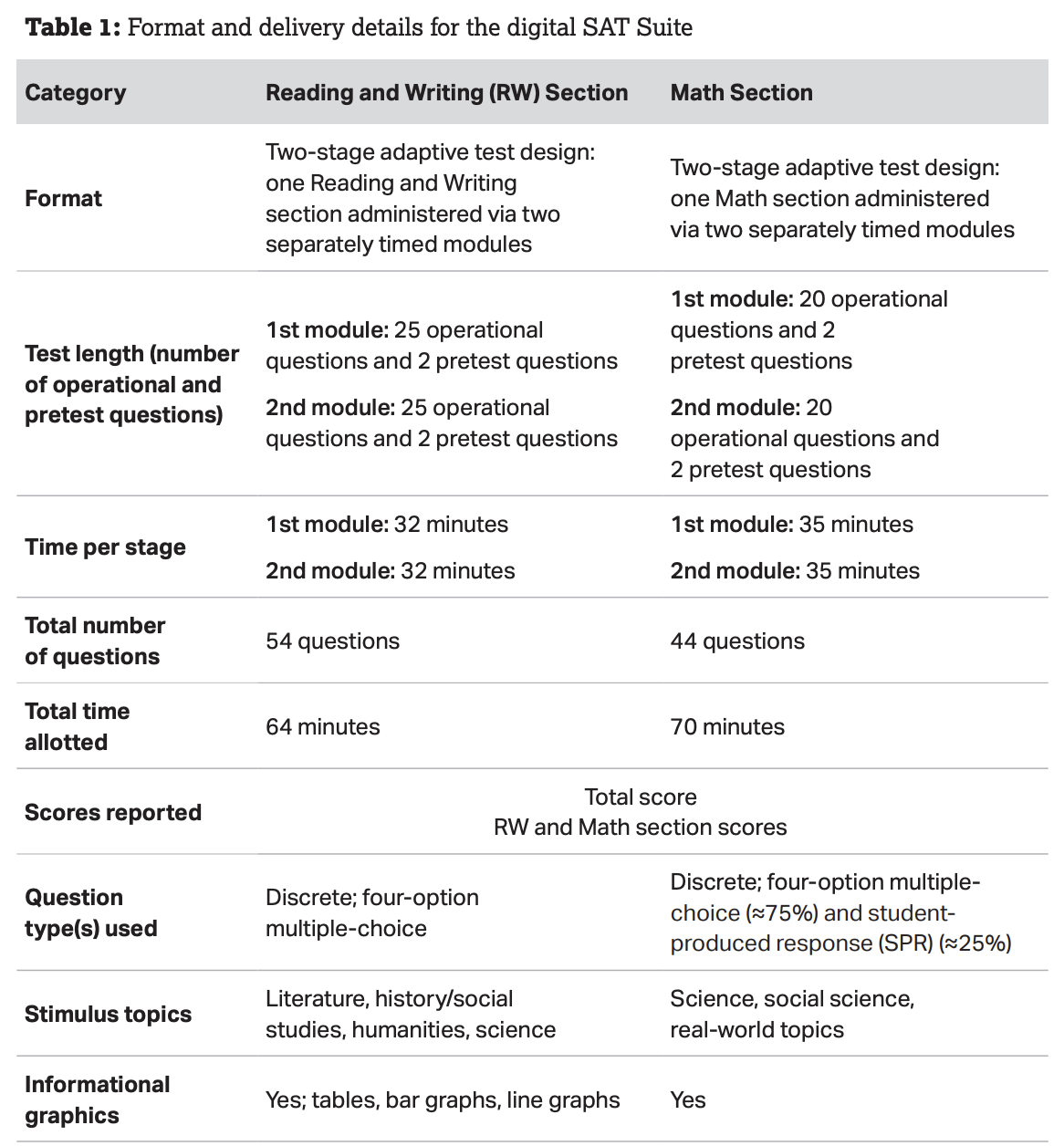College Board announced in January that the SAT is going digital. Starting for U.S. students in the spring of 2024, the SAT will only be available in a computer-based format. Recently, College Board released more details about the test, and we are sharing the most important information that has come to light in this post.
This blog post focuses on information about the new test. Stay tuned for a future post containing our advice on planning and preparing for the SAT in light of the transition to the new test.
In plain terms, the SAT will be exclusively digital for the high school Class of 2025 as of March of their junior year, and for younger students, the PSAT and SAT will be exclusively digital. The Class of 2025 will take the 11th grade PSAT in the digital format. For the Classes of 2024 and 2023, there will be no opportunity to take the Digital SAT before most college applications are due (typically December or January of senior year), so the new test should not concern them.
For international students, the timeline is moved up one year. International students in the Class of 2024 will take the Digital SAT in March of 2023 and the Digital PSAT in October 2022.
Scoring
The SAT will still be scored out of 1600, with 800 points coming from Math and 800 from Reading and Writing, as with the current paper and pencil test. College Board assures us that scores on the new Digital SAT will be directly comparable to scores from the current version of the test due to statistical equating, the same process by which they ensure that scores from the March 2018 SAT date are comparable to scores from the June SAT 2022 date.
We expect colleges to follow College Board’s guidance broadly, i.e. to treat scores on the two versions of the test in an apples-to-apples comparison.
Score Reports will now show students’ progress from any PSAT and SAT tests taken previously. They will also report not only a nationwide percentile, but percentiles by state, school district, and even high school. Score Reports will no longer contain cross-test scores. (If you have not heard of cross-test scores, that is because no one found them very useful.)
Digital SAT Format

The computer-based adaptive format allows the new Digital SAT to comprise 2 hours and 14 minutes of testing time, about one hour shorter than the current paper and pencil test. The test can maintain the same level of accuracy over a shorter sample of questions because it is adaptive to students’ performance (see next section).
The Reading and Writing section is composed of two 27 question modules timed for 32 minutes each. All questions are multiple-choice. Each question contains its own short, roughly paragraph-length passage. No longer will there be extended passages with multiple questions attached; each question is paired with its own short passage.

Meanwhile, the Math section is composed of two 22 question modules timed for 35 minutes each. Each module is roughly 75% multiple-choice and 25% student-produced response (i.e. open-ended). Students may use a calculator for the entire test, which is a departure from the current paper and pencil version. The Desmos graphing calculator will be embedded in the digital interface, though students will still have the option to bring their own calculator, and scratch paper will be provided.
Computer-Adaptive Testing
The Digital SAT and PSAT are section-adaptive tests, meaning that a student’s performance on the first module in each area will dictate the difficulty of the second module.
Because the Digital SAT is section-adaptive (like the GRE), not question-adaptive (like the GMAT), students are able to “question hop,” or leave a question blank and flag it to return later. The difficulty level of the second module is not calculated until the first module is submitted as complete.
There are two potential difficulty levels for the second module in both Reading and Writing and Math: one with an average difficulty easier than the first module, and one with an average difficulty harder than the first module. By comparison, the GRE uses three difficulty levels for its second modules.
Content of the Digital SAT
College Board claims that the Digital SAT tests the same content as the paper and pencil version, but admits that there are some changes to the relative frequencies of the topics.
Reading and Writing:
- Craft and Structure (~28%)
- Information and Ideas (~26%)
- Standard English Conventions (~26%)
- Expression of Ideas (20%)
The Assessment Framework released by College Board indicates that questions in similar Reading and Writing content areas will be grouped together to minimize students’ need to switch context while testing.
Math:
- Algebra (~35% of questions)
- Advanced Math (~35%)
- Problem-Solving and Data Analysis (~15%)
- Geometry and Trigonometry (~15%)
The Assessment Framework makes no mention of imaginary numbers in the Math content, and their omission (assuming it is deliberate in the Framework) would be a noteworthy departure from the current paper and pencil test.
You can view sample questions at this link.
Hardware and Software
Students will be permitted to use their own device, laptop, Chromebook, or tablet. They can bring an external mouse or keyboard. For students unable to bring their own device, College Board has committed to providing devices. They are looking into expanding to capability for smartphones to increase international access (in many countries, people may have an iPhone but no personal computer).
Students are permitted to bring their own calculator, though the Desmos graphing calculator will be built into the interface for test-takers to use. A hideable timer is included in the interface, which automatically gives a five minute warning for each module.
Because students download the testing application, students can continue testing through an internet outage. If the application or device crashes, students can resume the test with their progress saved. Students will still be testing under the supervision of a proctor, which serves as a deterrent for using this feature to cheat.
College Board plans to give schools more flexibility in offering School Day test dates throughout the year because of the flexibility of the digital format. Eventually, they hope to offer flexible start times for Saturday testers as well.
What about the ACT?
The ACT is available in a computer-based format for some state and district testing, but not for the national Saturday test dates. They do not have current plans to roll out nationwide digital testing, but we would not be surprised to see them roll it out in future years.
ACT has committed to keeping the paper and pencil option available to all students even if/when they do roll out computer-based testing nationally, whereas College Board has stated that they will only allow paper and pencil testing to students who qualify for accommodations.
A Word of Caution
Many students will be drawn to the computer-based shorter format of the Digital SAT. Still, we advise all students to complete diagnostic testing before starting preparation in order to find out whether the SAT or ACT is best for them. If the ACT is a better test for you, you should not be drawn to convenience over your higher potential ending score.
As mentioned above, we will have a future post regarding our guidance for students on planning for the Digital SAT.
Please contact us with any questions!
Changes to the PSAT
The PSAT will now be the exact same format as the SAT in terms of its number of questions per section and time limits. Currently, the PSAT has fewer questions than the SAT, and gives more time per question. The difficulty level of PSAT content will still be scaled down according to grade level.
PSAT scoring, however, will remain the same as it is now, with the PSAT 10 and PSAT/NMSQT being out of 1520 (760/760) and the PSAT 8/9 being out of 1440 (720/720).


